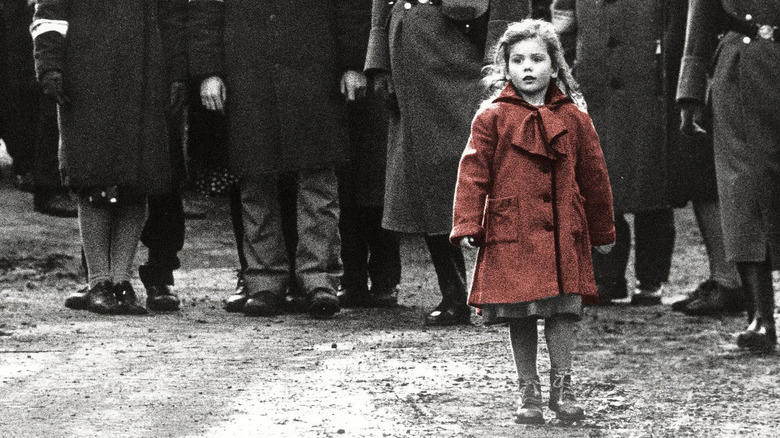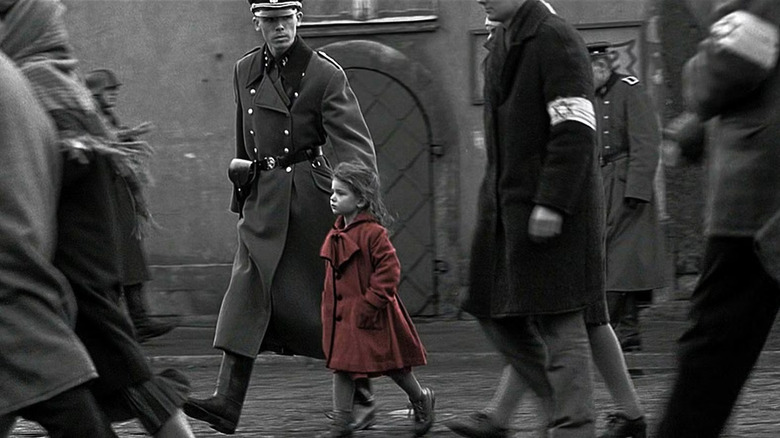The Meaning Behind The Red Coat Girl In Schindler's List, According To Steven Spielberg
Steven Spielberg's magnum opus "Schindler's List" is an unflinching depiction of the Holocaust's atrocities, and there are many scenes that rattle you to the core. One of these is the liquidation of the Kraków ghetto, where SS officers tear through the Jewish men and women's homes, toss their belongings off balconies, yank them onto the street, and line them up to shoot in a firing squad.
The scene is shot with a handheld camera, which mirrors Schindler's wandering eye. We see everything from a distance as Oskar Schindler watches from a hilltop while on a horseback ride. The framing also reinforces his elevated station as a wealthy man and member of the Nazi party himself. Since Schindler observes from so far away and with such a wide scope, the Jewish men and women appear like dollhouse figures, giving their slaughter an uncanny detachment. From the shock and sadness on his face, we realize that Schindler is confronted with the disturbing reality of what is happening in his country for the first time.
Amid the chaos and carnage, a little girl wanders the cobblestone streets, surprisingly unnoticed by the Nazi soldiers. The camera zooms in to match Oskar Schindler's narrowed focus on her. Her red coat is easy to spot because it stands out against the drab sea of black and white. A palpable, voyeuristic tension builds as she avoids the melee around her, and we fear that this small, innocent girl could be killed at any moment. The scene is deeply moving, but it also raises the question: why did Steven Spielberg choose the color red and this one character to stand out in an otherwise monochrome film?
A warning the world couldn't ignore
For "Schindler's List," Steven Spielberg set aside his blockbuster techniques to approach this serious material with reverence. Despite studio protestations, Spielberg was adamant that "Schindler's List" be filmed in black-and-white because it evoked historical material, such as the famous liberation photographs taken by Allied soldiers after they entered the horrific concentration camps. This makes the decision to add a splash of color stand out. In the oral history of "Schindler's List," Steven Spielberg explained his intentions with the red coat:
"I thought it meant much more than just an observation by Oskar. For me, it was like waving a red flag at a world that, because of their own antisemitism, refused to pay much attention to the Holocaust, including Roosevelt, Churchill and Eisenhower, who knew about the death camps because word had come down from the World Jewish Council. It was as obvious as a little girl in red."
During this scene, Oskar is finally paying attention. He collaborates with his accountant, Itzhak Stern, to bring over 1,000 Jewish people into his factory as workers, keeping them safe from genocide.
The bold color also brings to mind Little Red Riding Hood: an innocent girl cloaked in red, being stalked by a monster. When the little girl in "Schindler's List" ends up hiding under a bed, her coat turns gray, and she becomes just another victim. The next time she appears on screen, it is a stomach-churning image of her small, lifeless body being wheeled on a cart; her red coat blares against the black-and-white pile of corpses that surround her. Now, red symbolizes the spilled blood of millions. In its many forms, red is a blazing reminder of the individual lives lost in this devastating chapter of history.

